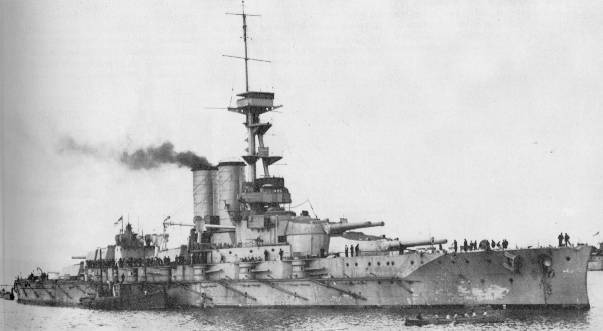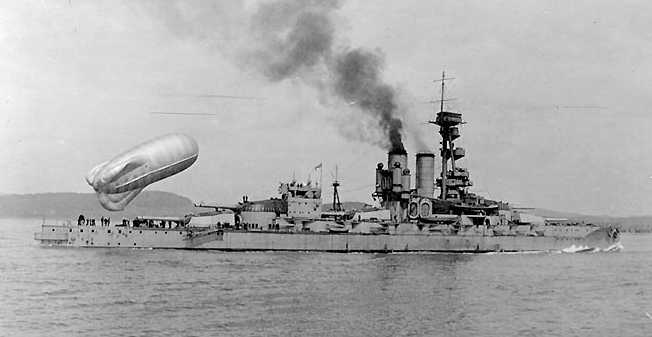Another Vickers export design, this one for the Turkish ship Reshadeih. This ship was taken over by Britain at the start of World War I and renamed HMS Erin.
Construction was very similar to the 13.5"/45 (34.3 cm) Mark V without the taper fit. Only ten Mark VI guns were made, so when one needed to be relined, it was replaced with a Mark V gun with a special propellant charge in order to give it the same muzzle velocity as the Mark VI.
| Designation | 13.5"/45 (34.3 cm) Mark VI |
|---|---|
| Ship Class Used On | Erin |
| Date Of Design | 1909 |
| Date In Service | 1914 |
| Gun Weight | With Breech: 171,584 lbs. (77,829 kg) |
| Gun Length oa | 625.9 in (15.9 m) |
| Bore Length | 607.5 in (15.431 m) |
| Rifling Length | N/A |
| Grooves | N/A |
| Lands | N/A |
| Twist | N/A |
| Chamber Volume | 16,800 in3 (275 dm3) |
| Rate Of Fire | 1.5 - 2 rounds per minute |
| Type | Bag |
|---|---|
| Projectile Types and Weights | APC Mark Ia - 1,400 lbs. (635.0 kg)
APC Mark IIIa (Greenboy) - 1,410 lbs. (639.6 kg) CPC - 1,400 lbs. (635.0 kg) HE - 1,400 lbs. (635.0 kg) |
| Bursting Charge | APC Mark Ia - 44.5 lbs. (20.2 kg)
APC Mark IIIa - 33 lbs. (15.0 kg) CPC - 117.5 lbs. (53.3 kg) HE - 176.5 lbs. (80.1 kg) |
| Projectile Length 1 | APC Mark Ia - 49.6 in (126 cm)
APC Mark IIIa - 49.2 in (125 cm) CPC - 59.8 in (151.9 cm) |
| Propellant Charge 2 | 297 lbs. (135 kg) |
| Muzzle Velocity | 2,445 fps (745 mps) |
| Working Pressure | N/A |
| Approximate Barrel Life | 300 rounds |
| Ammunition stowage per gun | 80 rounds |
- ^The projectile lengths given are average numbers. There were as many as five different manufacturers for these munitions, each producing a slightly different projectile from the others.
- ^The propellant charge for the single Mark V gun carried by HMS Erin was 288 lbs. (130.6 kg) in order to obtain the same muzzle velocity as the Mark VI guns.
- For other information regarding ammunition for these guns, please see the 13.5"/45 (34.3 cm) Mark V datapage.
| Range | KC-type Side Armor | Deck Armor | Striking Velocity |
|---|---|---|---|
| 0 yards (0 m) | 17.3" (439 mm) | --- | 2,500 fps (762 mps) |
| 10,000 yards (9,144 m) | 12.5" (318 mm) | --- | 1,850 fps (564 mps) |
- Data from "British Battleships of World War Two."
- The penetration figures in this table are for an uncapped AP shell striking the plate at 90 degrees, i.e., with the axis of the shell perpendicular to the face of the plate. A capped shell would give about 10 to 20% improvement at low velocities and about 30 to 50% at high velocities.
| Designation | Twin Mount
Erin (5): 13.5-in "Special" |
|---|---|
| Weight | 600 tons (610 mt) |
| Elevation | -3 / +20 degrees |
| Rate of Elevation | N/A |
| Train 1b | Forward and aft turrets: about -150 / +150 degrees
Q turret: about 30 to 150 degrees on either side |
| Rate of Train | N/A |
| Gun Recoil | N/A |
| Loading Angle | Any |
- ^Superfiring turrets could not fire within 30 degrees of the axis because the blast effects would have penetrated into the lower turrets through the sighting hoods.
- "Q" turret was a deck higher than in contemporary British 13.5" (34.3 cm) battleships, making the amidship mounting drier as a result.
"The Grand Fleet: Warship Design and Development 1906 - 1922" by D.K. Brown
"British Battleships of World War One" by R.A. Burt
"Naval Weapons of World War Two," "Jutland: An Analysis of the Fighting" and "British Naval Guns 1880-1945 No 2" article in "Warships Volume V" all by John Campbell
"Battleship Design and Development 1905-1945" by Norman Friedman
"The Big Gun: Battleship Main Armament 1860-1945" by Peter Hodges
"British Battleships: 1860 - 1950" by Oscar Parkes
"British Battleships of World War Two" by Alan Raven and John Roberts
---
ADM 186/169 "Shell Committee: Reports 1917 and 1918"
---
Special help from Neil Stirling
05 August 2006 - Benchmark
11 February 2012 - Updated to latest template
01 February 2014 - Added ammunition information and note on turret "Q"
16 September 2016 - Converted to HTML 5 format
29 February 2020 - Reorganized notes


